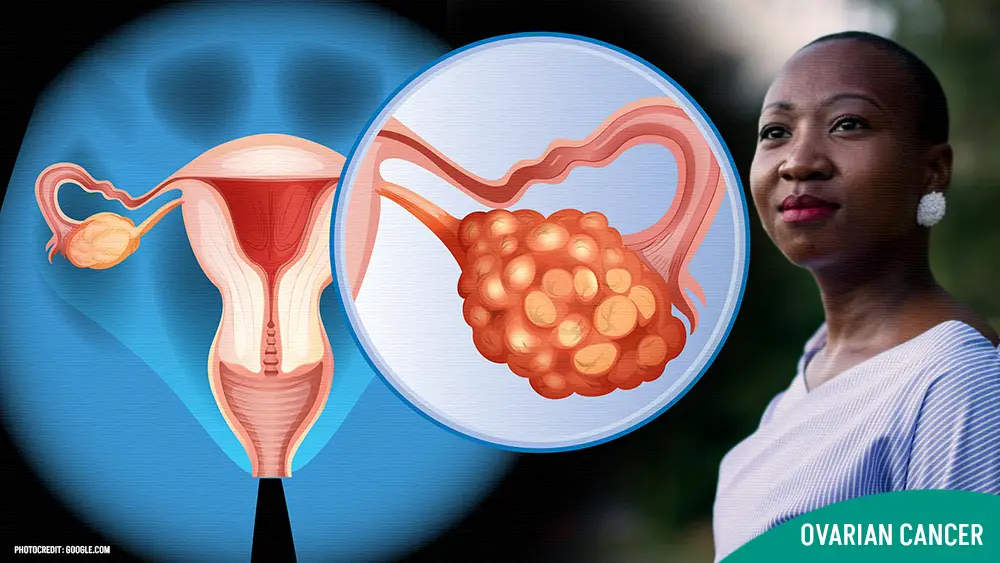
HEALTH BLOG
What is Ovarian Cancer With Survival Rates and Cancer Research in 2024
-
Rahul Priydarss
Discover the comprehensive guide to ovarian cancer, covering its introduction, types, causes, symptoms, diagnosis, treatment options, and ongoing research in 2024. Learn about the latest advancements, survival rates, and how to manage side effects effectively. Get answers to FAQs and understand the importance of early detection and personalized care. Empower yourself with knowledge to navigate the complexities of ovarian cancer and make informed decisions for your health and well-being.
Introduction to Ovarian Cancer:
Ovarian cancer is a type of cancer that begins in the ovaries, the female reproductive organs responsible for producing eggs (ova) and hormones like estrogen and progesterone. It is the fifth most common cancer among women and is often referred to as the “silent killer” because symptoms may not appear until the disease has progressed to an advanced stage.
What is Ovarian Cancer:
Ovarian cancer is a malignancy that originates in the ovaries, the female reproductive organs responsible for producing eggs and hormones. This type of cancer occurs when cells in the ovaries undergo abnormal changes, leading to uncontrolled growth and the formation of tumors. Ovarian cancer can affect women of all ages, but it is most commonly diagnosed in women who are over 50 years old. It is often referred to as the “silent killer” because symptoms may not become apparent until the disease has reached an advanced stage, making early detection challenging.

Table of Contents
Types of Ovarian Cancer:
There are several types of ovarian cancer, each classified based on the specific cells from which they originate within the ovaries.
Epithelial Ovarian Cancer: This is the most common type of ovarian cancer, accounting for about 90% of cases. It begins in the cells that line the outer surface of the ovary. Epithelial ovarian cancer can further be categorized into serous, endometrioid, mucinous, and clear cell subtypes, each with distinct characteristics and treatment approaches.
Germ Cell Tumors: Germ cell tumors develop from the cells that produce eggs in the ovaries. These tumors are less common than epithelial ovarian cancer and often occur in younger women. Subtypes of germ cell tumors include dysgerminoma, immature teratoma, and yolk sac tumor.
Stromal Tumors: Stromal tumors originate from the cells that produce hormones and support the structure of the ovaries. They account for a small percentage of ovarian cancers and include subtypes such as granulosa cell tumors and Sertoli-Leydig cell tumors.
Causes and Risk Factors of Ovarian Cancer:
Ovarian cancer is influenced by a combination of genetic and environmental factors. Understanding these factors is crucial for identifying individuals at higher risk and implementing preventive measures.
Genetic Factors: Genetic predisposition plays a significant role in ovarian cancer risk. Mutations in certain genes, such as BRCA1 and BRCA2, inherited from one’s parents, significantly increase the likelihood of developing ovarian cancer. Additionally, mutations in genes associated with Lynch syndrome and hereditary breast and ovarian cancer syndrome can also elevate the risk. Even without identified mutations, a family history of ovarian or breast cancer can indicate an increased susceptibility to the disease.
Environmental Factors: Environmental exposures can contribute to ovarian cancer risk. Prolonged exposure to certain substances or toxins, such as asbestos, talcum powder, and certain pesticides, has been linked to an increased risk. Additionally, lifestyle factors like smoking and obesity can also influence the likelihood of developing ovarian cancer. Reproductive factors, including never having been pregnant or starting menstruation at an early age, are also associated with altered ovarian cancer risk.
Symptoms of Ovarian Cancer:
Ovarian cancer is often referred to as the “silent killer” because it can develop without causing noticeable symptoms in its early stages. However, as the cancer progresses, it may cause various symptoms that should not be ignored. It’s essential to be vigilant about these signs and consult a healthcare professional if they persist or worsen.
Abdominal Bloating or Swelling: Persistent bloating or swelling in the abdomen, often accompanied by feelings of fullness or discomfort, can be an early indicator of ovarian cancer.
Pelvic Pain: Unexplained pelvic pain or discomfort that doesn’t go away, especially if it’s frequent or severe, maybe a symptom of ovarian cancer.
Difficulty Eating or Feeling Full Quickly: If you experience a loss of appetite, difficulty eating, or feeling full after eating only a small amount, it could be a sign of ovarian cancer, particularly if it persists for an extended period.
Changes in Bowel Habits: Persistent changes in bowel habits, such as constipation, diarrhea, or a change in the size or frequency of bowel movements, may indicate ovarian cancer.
Urinary Symptoms: Ovarian cancer can sometimes cause urinary symptoms such as urgency, frequency, or difficulty emptying the bladder.
Fatigue: Generalized fatigue or low energy levels that don’t improve with rest may be associated with ovarian cancer, especially if other symptoms are present.
Back Pain: In some cases, ovarian cancer can cause persistent lower back pain that doesn’t improve with usual treatments.
Menstrual Changes: Changes in menstrual patterns, such as irregular periods or abnormal bleeding, may sometimes be a sign of ovarian cancer, although they are more commonly caused by other conditions.
Unexplained Weight Loss: Significant and unexplained weight loss without changes in diet or physical activity can be a symptom of ovarian cancer, particularly if it occurs rapidly.
Diagnosis and Staging of Ovarian cancer:
Medical History and Physical Examination: The diagnostic process typically begins with a thorough medical history review and physical examination by a healthcare professional. They will inquire about any symptoms you may be experiencing and assess your overall health.
Imaging Tests: Imaging tests such as transvaginal ultrasound, pelvic CT scan, or MRI may be performed to visualize the ovaries and surrounding structures. These tests help identify any abnormalities or masses that may indicate ovarian cancer.
Blood Tests: Blood tests, including the CA-125 tumor marker test, may be conducted to measure levels of specific proteins that can be elevated in the presence of ovarian cancer. However, CA-125 levels can also be elevated in other conditions, so this test is not definitive on its own.
Biopsy: A biopsy is the definitive method to diagnose ovarian cancer. It involves removing a small sample of tissue from the ovary or a suspicious mass for examination under a microscope. This procedure is typically performed during surgery, such as a laparoscopy or laparotomy.
Staging of Ovarian cancer:
Once ovarian cancer is diagnosed, it is staged to determine the extent of the disease and guide treatment decisions. The staging system commonly used for ovarian cancer is the FIGO (International Federation of Gynecology and Obstetrics) staging system.
- Stage I: Cancer is confined to one or both ovaries.
- Stage II: Cancer has spread to other pelvic organs, such as the fallopian tubes or uterus.
- Stage III: Cancer has spread beyond the pelvis to the abdominal lining or lymph nodes.
- Stage IV: Cancer has metastasized to distant organs, such as the liver or lungs.
Staging may involve additional imaging tests, such as CT scans or PET scans, to assess the extent of the disease spread. Once staging is complete, treatment options, including surgery, chemotherapy, and radiation therapy, are determined based on the stage of the cancer and other factors such as the patient’s overall health and preferences.
Treatment Options for Ovarian Cancer:
The treatment of ovarian cancer depends on several factors, including the stage of the cancer, the type of ovarian cancer, the overall health of the patient, and their preferences. A multidisciplinary approach involving a team of healthcare professionals, including gynecologic oncologists, medical oncologists, and radiation oncologists, is often employed to provide comprehensive care. Treatment options may include.
Surgery:
Primary Debulking Surgery: This procedure involves removing as much of the tumor as possible, along with the affected ovary or ovaries, fallopian tubes, uterus, and nearby lymph nodes. The goal is to achieve optimal debulking, meaning minimal residual disease remains.
Fertility-Sparing Surgery: In select cases, where the cancer is confined to one ovary and fertility preservation is desired, a conservative surgical approach may be considered to remove the affected ovary and preserve fertility.
Chemotherapy:
Chemotherapy is often recommended after surgery to kill any remaining cancer cells and reduce the risk of cancer recurrence. It may be administered intravenously or directly into the abdominal cavity (intraperitoneal chemotherapy). The specific chemotherapy drugs and regimens depend on the stage and type of ovarian cancer.
Targeted Therapy:
Targeted therapy drugs, such as PARP inhibitors, may be used to treat ovarian cancer, particularly in cases with specific genetic mutations like BRCA1 or BRCA2. These drugs interfere with the ability of cancer cells to repair DNA damage, leading to their death.
Immunotherapy:
Immunotherapy drugs, such as checkpoint inhibitors, are being studied for their potential to treat ovarian cancer by boosting the body’s immune response against cancer cells. Clinical trials are ongoing to evaluate the efficacy and safety of immunotherapy in ovarian cancer treatment.
Radiation Therapy:
Radiation therapy uses high-energy beams to target and destroy cancer cells. It may be used in combination with surgery and/or chemotherapy, particularly in cases where the cancer has spread to nearby tissues or organs.
Clinical Trials:
Participation in clinical trials may offer access to novel treatments and therapies that are not yet widely available. These trials aim to evaluate new treatment approaches and improve outcomes for individuals with ovarian cancer.

Managing Side Effects of Ovarian Cancer:
Treatment for ovarian cancer, including surgery, chemotherapy, and radiation therapy, can often result in side effects that may impact a patient’s quality of life. Managing these side effects is essential to help patients cope with their treatment and maintain overall well-being. Here are some common side effects of ovarian cancer treatment and strategies for managing them.
Nausea and Vomiting:
- Anti-nausea medications (antiemetics) prescribed by your healthcare provider can help alleviate nausea and vomiting.
- Eating smaller, more frequent meals and avoiding greasy or spicy foods may also help reduce nausea.
- Ginger supplements or ginger tea may provide relief from nausea.
Fatigue:
- Balancing rest and activity is crucial. Plan periods of rest throughout the day and conserve energy for essential tasks.
- Engage in gentle exercise, such as walking or yoga, to help combat fatigue and improve energy levels.
- Ensure adequate nutrition and hydration to support your body’s energy needs.
Hair Loss (Alopecia):
- Discuss hair loss prevention strategies with your healthcare provider before starting chemotherapy.
- Consider wearing scarves, hats, or wigs to cover your head and protect your scalp if hair loss occurs.
- Use gentle hair care products and avoid heat styling tools to minimize further damage to your hair.
Loss of Appetite and Weight Loss:
- Choose nutrient-rich foods that are easy to digest, such as fruits, vegetables, lean proteins, and whole grains.
- Eat small, frequent meals throughout the day rather than large meals.
- Stay hydrated by drinking plenty of fluids, including water, herbal teas, and clear broths.
Neuropathy (Nerve Damage):
- Report any symptoms of neuropathy, such as numbness, tingling, or pain in the hands and feet, to your healthcare provider.
- Use protective measures, such as wearing gloves and comfortable, supportive shoes, to prevent injury.
- Physical therapy or occupational therapy may help manage neuropathy symptoms and improve function.
Emotional Distress:
- Seek support from friends, family members, support groups, or mental health professionals to cope with the emotional challenges of ovarian cancer treatment.
- Practice relaxation techniques, such as deep breathing, meditation, or mindfulness, to reduce stress and promote emotional well-being.
- Stay connected with loved ones and engage in activities that bring you joy and comfort.
Skin Changes:
- Use gentle, fragrance-free skincare products to soothe and moisturize dry or irritated skin.
- Protect your skin from the sun by wearing sunscreen, and protective clothing, and avoiding prolonged sun exposure.
Ovarian Cancer Research in 2024:
There’s positive movement in ovarian cancer research this year (2024) with a focus on several areas.
New Treatments:
Antibody-drug conjugates (ADCs) are making strides. A recent FDA approval of mirvetuximab soravtansine for platinum-resistant ovarian cancer shows promise [UCLA Health article on ADC].
Clinical trials are ongoing, with funding announcements like the Ovarian Cancer Research Program by the Congressionally Directed Medical Research Program [CDMRP website].
Early Detection: Researchers are looking for ways to identify ovarian cancer at earlier stages for better outcomes.
Precision Medicine: Tailoring treatments to a patient’s specific genetic makeup of the cancer is an area of active research.
Improving Quality of Life: There’s a focus on managing the
side effects of treatment and improving the overall well-being of patients.
Here are some upcoming events for ovarian cancer research in 2024:
- The 15th Biennial Ovarian Cancer Research Symposium – September 20-21 [https://rivkin.org/]
- The 15th HHMT International Forum on Ovarian Cancer – October 6-9 [ovarian.org.uk]
As of 2024, ovarian cancer research continues to be a focal point in the medical community’s efforts to improve prevention, diagnosis, and treatment outcomes for this challenging disease. Several key areas of research are actively pursued.
Early Detection and Screening Methods: Scientists are exploring innovative approaches to enhance early detection of ovarian cancer, aiming to identify the disease at its earliest and most treatable stages. This includes investigating novel biomarkers, imaging techniques, and risk assessment tools that may improve screening accuracy and reduce false-positive results.
Genetic and Molecular Insights: Research into the genetic and molecular mechanisms underlying ovarian cancer is ongoing, with a focus on identifying key genetic mutations, pathways, and biomarkers associated with disease development and progression. Understanding these molecular drivers may lead to targeted therapies and personalized treatment approaches tailored to individual patients’ genetic profiles.
Immunotherapy and Targeted Therapies: Immunotherapy, including immune checkpoint inhibitors and adoptive cell therapies, is being explored as a promising treatment approach for ovarian cancer. Additionally, targeted therapies such as PARP inhibitors continue to be investigated for their efficacy in specific patient subgroups, particularly those with BRCA mutations or homologous recombination deficiency.
Combination Therapies: Researchers are evaluating the efficacy of combining different treatment modalities, such as chemotherapy, targeted therapy, and immunotherapy, to enhance treatment response and overcome resistance mechanisms in ovarian cancer. Clinical trials are underway to assess the safety and efficacy of various combination regimens in different stages and subtypes of ovarian cancer.
Precision Medicine and Personalized Treatment: Advances in genomic profiling and precision medicine technologies are driving efforts to tailor ovarian cancer treatment strategies to individual patients’ molecular and genetic profiles. This includes identifying predictive biomarkers of treatment response and developing algorithms to guide treatment decisions based on tumor characteristics and patient-specific factors.
Supportive Care and Survivorship: Research focusing on supportive care interventions, symptom management, and survivorship programs aims to improve the overall quality of life for ovarian cancer patients. This includes addressing psychosocial needs, managing treatment-related side effects, and promoting holistic well-being throughout the cancer journey.
ovarian cancer survival rate:
The survival rate for ovarian cancer varies depending on several factors, including the stage at which the cancer is diagnosed, the type of ovarian cancer, the age and overall health of the patient, and the effectiveness of treatment. Generally, ovarian cancer has a lower survival rate compared to some other types of cancer, primarily due to its often advanced stage at diagnosis.
According to the American Cancer Society, the overall five-year survival rate for ovarian cancer is around 48%. However, this statistic can vary significantly based on the stage of the cancer at diagnosis.
- Localized Stage (confined to the ovaries): The five-year survival rate for ovarian cancer diagnosed at a localized stage is approximately 92%.
- Regional Stage (spread to nearby organs or lymph nodes): The five-year survival rate for ovarian cancer diagnosed at a regional stage is about 75%.
- Distant Stage (spread to distant organs or tissues): The five-year survival rate for ovarian cancer diagnosed at a distant stage is much lower, around 30%.
FAQs about Ovarian Cancer:
A1: Currently, there is no reliable screening test for ovarian cancer. However, women at high risk may benefit from regular monitoring and genetic testing.
A2: The outlook for ovarian cancer depends on various factors, including the stage of the disease and how well it responds to treatment. While some women achieve remission, others may experience recurrence.
A3: Long-term side effects of ovarian cancer treatment may include infertility, early menopause, and an increased risk of osteoporosis. It’s essential to discuss potential side effects with your healthcare provider before starting treatment.
A4: In some cases, ovarian cancer may be hereditary, especially if there is a family history of the disease or certain genetic mutations, such as BRCA1 and BRCA2.
A5: Supporting a loved one with ovarian cancer involves offering emotional support, helping with practical tasks, and being a good listener. Encourage your loved one to seek support from healthcare professionals and support groups.

-Please remember, to always consult with healthcare professionals or Doctors for personalized advice related to medical conditions.
Conclusion:
Ovarian cancer is a complex disease that requires comprehensive treatment and support. By understanding the risk factors, symptoms, and treatment options for ovarian cancer, women can take proactive steps to protect their health and well-being.




